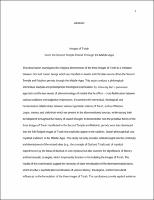Please use this identifier to cite or link to this item:
https://hdl.handle.net/20.500.12202/6828| Title: | Images of Torah from the Second Temple Period through the Middle Ages. |
| Authors: | Dauber, Jonathan V. Rynhold, Daniel Hidary, Richard Clifford, Richard J. Heo, Jeong Mun. |
| Keywords: | Judaica studies philosophy of religion theology Jewish mysticism and philosophy Jewish-Christian Dialogue logos mystical union Torah wisdom |
| Issue Date: | May-2021 |
| Citation: | Heo, J.M. (2021, May). Images of Torah from the Second Temple Period through the Middle Ages (Publication No. 28543954) [Doctoral dissertation, Yeshiva University]. PQDT |
| Abstract: | This dissertation investigates the religious phenomenon of the three images of Torah as a mediator between God and human beings which are manifest in Jewish and Christian sources from the Second Temple and Rabbinic periods through the Middle Ages. This study conducts a philological-intertextual analysis and philosophical-theological examination, by following Idel’s panoramic approach and the two senses of phenomenology of models that he offers—cross-fertilization between various traditions and subjective impressions. It examines the intertextual, theological, and hermeneutical relationships between various hypostatic notions of Torah, such as Wisdom, Logos, memra, and shekhinah which are present in the aforementioned sources, while tracing their development throughout the history of Jewish thought. It demonstrates how the primitive forms of the three images of Torah manifested in the Second Temple and Rabbinic periods were later developed into the full-fledged images of Torah that explicitly appear in the rabbinic, Jewish philosophical, and mystical traditions in the Middle Ages. This study not only provides critical insight into the continuity and development of the related ideas (e.g., the concepts of God and Torah) and of mystical experiences (e.g. the ideas of devekut or unio mystica) but also examine the significance of literary and hermeneutic strategies, which importantly function in formulating the images of Torah. The results of this examination suggest the necessity of close reevaluation of the developmental process, which involve a sophisticated combination of various literary, theological, and hermeneutical influences on the formulation of the three images of Torah. The conclusions provide explicit evidence of the continuity of an inner and hidden channel transmitting the shared ideas, which function in formulating the images of Torah as mediators along with the mechanism of devekut and unio mystica recurrent from the ancient (Second Temple) and rabbinic sources through the medieval philosophic and Kabbalistic sources. This study eventually provides not only a comprehensive and innovative way of depicting a clearer picture of the phenomenological features of these images of Torah but also offers critical theological and philosophical implications of the phenomenology of Torah in Jewish philosophy and Jewish mysticism. |
| Description: | Doctoral dissertation / Embargo till May, 2023 |
| URI: | https://hdl.handle.net/20.500.12202/6828 https://ezproxy.yu.edu/login?url=https://www.proquest.com/dissertations-theses/images-torah-second-temple-period-through-middle/docview/2544491395/se-2 |
| Appears in Collections: | Bernard Revel Graduate School of Jewish Studies: Doctoral Dissertations |
Files in This Item:
| File | Description | Size | Format | |
|---|---|---|---|---|
| HEO JM Images of Torah OA May 2021.pdf | 2.57 MB | Adobe PDF |  View/Open |
This item is licensed under a Creative Commons License

